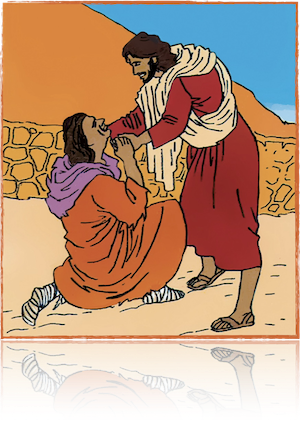
The Healing of the Ten Lepers by Jesus Christ
by Fr. Cyril Veliath, SJ1st Row
Luke 17: 11-19
In today's Gospel passage, we encounter the story of ten lepers whom Jesus healed, yet only one returned to thank him. Throughout history, many civilizations viewed leprosy as a curse from the gods. People believed that lepers had committed terrible sins and were being punished by God. Regardless of their innocence or guilt, they were seen as abominable sinners. Lepers were forcibly separated from their families, friends, and loved ones, often relegated to remote areas. In some cultures, they even received a funeral while still alive, symbolizing their status as "dead" to the world. They were excluded from churches and forbidden to participate in society, and whenever they encountered others, they had to ring a bell to warn people not to come close. Various nations enforced laws that effectively isolated them and dictated their conduct and livelihood.

The terms "leper" and "leprosy" appear over 40 times in the Bible, depending on the translation. Leprosy was common during biblical times, and the numerous references to it resonated with people living in unsanitary conditions. One reason leprosy is frequently mentioned in the Bible is that it served as a vivid illustration of the destructive power of sin and its debilitating effect on a person's life. Ancient Jewish laws identified 61 objects that could defile a person, with a dead body being the worst, followed closely by a leper.
After healing the lepers, Jesus instructed them to go and show themselves to the priests. While the priests could not cure the disease, they had the authority to confirm the lepers' healing and provide a certificate of restoration, allowing them to reintegrate into society. Importantly, not all the lepers were healed instantly; they received their healing as they made their way to the temple, which happened because they obeyed the Lord's command.
Remarkably, only one leper, upon realizing he was healed, turned back, fell at Jesus’ feet, and offered thanks, glorifying God with a loud voice. This man was a Samaritan, a group often marginalized, illustrating how those who are oppressed can be closest to God through their gratitude.
One might wonder what happened to the other nine lepers who did not return to thank Jesus. While they may not have expressed their gratitude directly to him, it is reasonable to believe they showed their thankfulness to God in other ways. When Jesus healed the ten lepers, he not only restored their bodies but also transformed their souls, making them loving, generous, compassionate, and kindhearted individuals.

